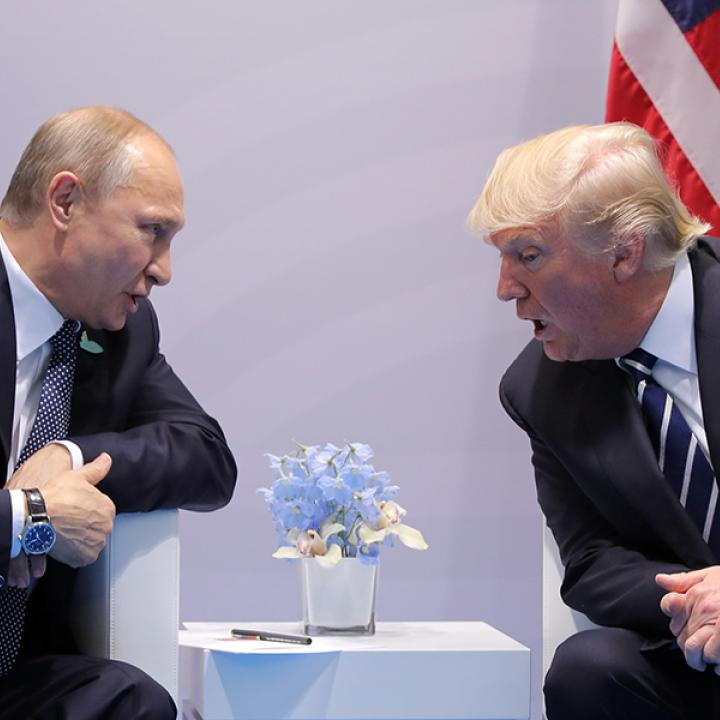
- Policy Analysis
- Interviews and Presentations
Getting Syria Right at the Trump-Putin Summit

Keeping U.S. troops in place is critical to our national security, but American interests don't require the large-scale, long-term ground force that many fear.
On Monday, President Trump will confront a charged agenda in a summit with Vladimir Putin. North Korea, Iran, Ukraine/Crimea, and a host of contentious bilateral issues offer little apparent ground for a common approach by Washington and Moscow.
Speculation persists of a possible deal with Russia on Syria. Yet caution is required, for no decision is more likely to affect the course of events in the Middle East in the coming years than the question of how long to retain U.S. forces in Syria. And there can be little doubt that any deal Putin proffers will hinge on withdrawal of U.S. forces—the very ones that have been critical to destroying the violent jihadist homeland in Syria. Seven years on, the terrible civil war there draws inexorably to a close, alongside the U.S. campaign to crush the Islamic State, or at least this phase of it.
Make no mistake, these small U.S. forces have an outsize significance for both our friends and enemies. At modest cost and risk, they offer substantial benefit to U.S. national security. Carefully integrated into a larger strategy, a small, nimble U.S. force presence offers a powerful obstacle to two threats—a regenerated Islamic State, and Iran's effort to use Syria as a power projection platform in the heart of the Arab Middle East and against Israel.
America's closest regional allies lost faith in the Obama administration because of its perceived disengagement from the Middle East. Yet once again, and perhaps more profoundly, the issue of U.S. commitment to its allies—and to broader stability and security—is being widely questioned. Why? Because of the Trump administration's hesitancy on Syria and the widening gap between its rhetoric and the reality of its Iran policy. Reimposing sanctions on Iran is easy but will be insufficient to reverse the gains Tehran has made on Middle East battlefields through the IRGC and a growing army of proxies. Indeed, there is a growing suspicion in the region that this administration does not have the stomach to complete the hard work required to limit Iran's destabilizing activities.
Syria is ground zero for that effort, especially as Tehran accelerates its campaign to construct a permanent defense and intelligence architecture there. Iranian aims conflict squarely with Israeli security, and the IDF has repeatedly taken action to blunt Syria's transformation into a platform for attacks against the Jewish state.
Left unchecked, Iran's deepening involvement in Syria would also reheat Sunni extremism on the embers of the civil war. The Assad regime's Iranian-backed crackdown had a terrifying bellows effect on Iraq, fostering a caliphate that spanned two countries, waves of international terrorism, attacks within the United States, and foreign fighter recruitment at a pace that threatened to paralyze police and intelligence services around the world. We cannot risk a return to those days by prematurely withdrawing American troops.
Syria's agony will not be quelled—nor its potential to destabilize Jordan, Lebanon, and Europe with violence-propelled surges of refugees—by the current "peace of the grave" approach taken by Moscow and Tehran. The chaotic brutality of the Assad regime's effort to retake southwestern Syria, assisted by Russian airpower and foreign fighters provided by Iran and Hezbollah, is a chilling reminder if one is needed.
But this is not an inevitable outcome. Ironically, we have the stronger allies and the means to counter the Iranians and their proxies in order to shape a different future for Syria. As presented in a new study by The Washington Institute, we can do so by taking the following steps:
First, maintain a U.S. military presence—sized to the task and complemented with a no-fly/no-drive zone to prevent the Islamic State's regeneration—to deny these areas to Iranian-backed forces supporting the weakened Assad regime, and to prevent an Iranian "land bridge" to the Mediterranean.
Second, work out an understanding with Turkey in the north that would permit the United States and its allies to exercise control over 40 percent of Syria's territory, including the country's most resource-rich tier.
Third, with our Gulf allies, target banks providing credit to the Assad regime, Iranian support to proxies in Syria, and Assad cronies who facilitate Iranian investments in Syria.
Fourth, ask our Gulf partners to provide assistance to northeast Syria and to promote its economic well-being. That will require not just donating assistance, but also finding alternative markets for the area's oil and agricultural exports.
Fifth, emphasize the need for full implementation of UN Security Council Resolution 2254, which offers a pathway to a political outcome in Syria.
And lastly, convey to Moscow that we will back Israeli strikes against Iranian/Shia militias in Syria, essentially forcing the Russians (and Damascus) to choose between keeping the Assad regime in power or allowing Iran, Hezbollah, and other foreign Shia proxies to remain in Syria.
Getting U.S. strategy right on Syria is critical to our national security. It does not require a large, long-term U.S. ground force; indeed, as in Iraq, our military forces should be tailored to the evolving requirements before us. But we have ground to make up, since Iran and Russia got there before us. Their legacy lies in Syria's ravaged landscape and millions of refugees, a situation that could easily resurrect a host of violent extremists. In that context, a disordered Syria dominated by Iran offers dire repercussions for the region—and the U.S. homeland—absent a forthright U.S. decision to play the cards we have.
The authors are former ambassadors who are now senior fellows at The Washington Institute for Near East Policy.





